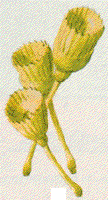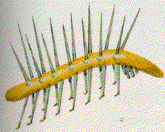Miscellaneous
Anomalocaris canadensis
 At about 0.5 m in length Anomalocaris was the largest soft-bodied predator among the Burgess fauna. The body was flanked by 11 pairs of fins which were used to propel the animal through the water. Thus, this organism was probably a swimmer, although it may have also rested on the sea- floor
at times. The mouth of Anomalocaris is a story in itself. For more than 70 years the pineapple-shaped eating apparatus was interpreted a jellyfish!
At about 0.5 m in length Anomalocaris was the largest soft-bodied predator among the Burgess fauna. The body was flanked by 11 pairs of fins which were used to propel the animal through the water. Thus, this organism was probably a swimmer, although it may have also rested on the sea- floor
at times. The mouth of Anomalocaris is a story in itself. For more than 70 years the pineapple-shaped eating apparatus was interpreted a jellyfish!
Dinomischus isolatus
 Dinomischus was a rare (only 3 specimens are known), sessile, plant-like creature 20 mm in length. It stood vertically with the stalk embedded in the sediment. The stalk supported a cup-shaped body at the top. Hairs present on the arms of the cup may have been used by this probably filter feeder to create water currents.
Dinomischus was a rare (only 3 specimens are known), sessile, plant-like creature 20 mm in length. It stood vertically with the stalk embedded in the sediment. The stalk supported a cup-shaped body at the top. Hairs present on the arms of the cup may have been used by this probably filter feeder to create water currents.
Hallucigenia sparsa
 Only 40 specimens of Hallucigenia are known. The name Hallucigenia refers to its bizarre and dream-like appearance. Hallucigenia bore seven pairs of walking spines. Seven tentacles on the dorsal surface were used to grasp food with.
Only 40 specimens of Hallucigenia are known. The name Hallucigenia refers to its bizarre and dream-like appearance. Hallucigenia bore seven pairs of walking spines. Seven tentacles on the dorsal surface were used to grasp food with.
More miscellaneous species
Return to fossil menu
Return to table of contents